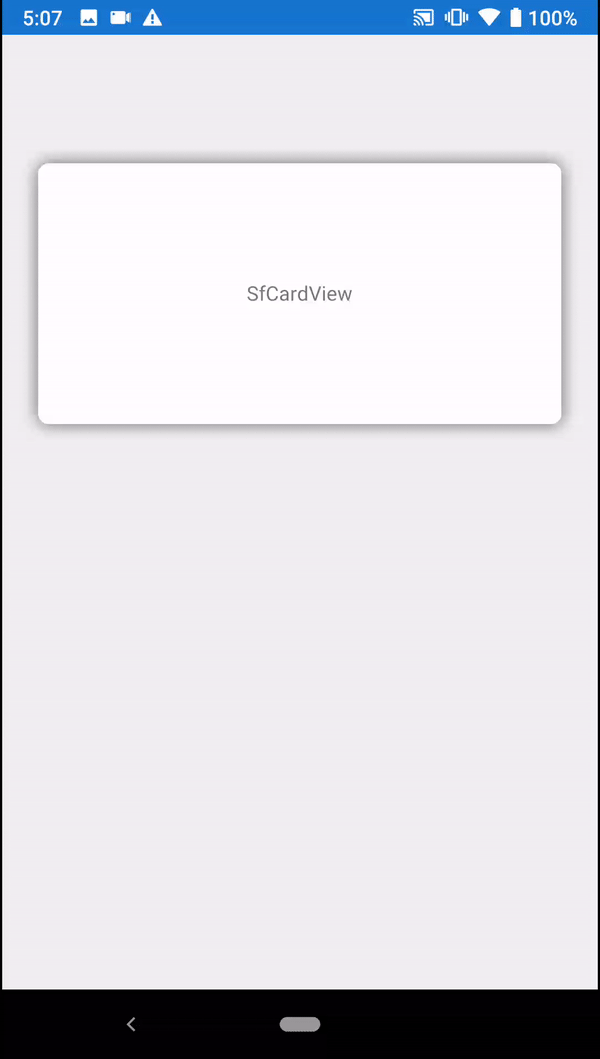Getting Started with Xamarin Cards
10 Oct 20236 minutes to read
This section explains you the steps required to add content to Xamarin Cards with indicator and add SfCardView to SCardLayout. This section covers only the minimal features needed to get started with the cards.
Assembly deployment
After installing Essential Studio for Xamarin, you can find all the required assemblies in the installation folders, {Syncfusion Essential Studio Installed location} \Essential Studio\{Version #}\Xamarin\lib.
E.g.: C:\Program Files (x86) \Syncfusion\Essential Studio\19.1.0.54\Xamarin\lib
NOTE
Assemblies can be found in unzipped package location(Documents/Syncfusion/{Version #}/Xamarin/lib) in Mac.
Adding cards reference
You can add cards reference using one of the following methods:
Method 1: Adding cards reference from nuget.org
Syncfusion Xamarin components are available in nuget.org. To add cards to your project, open the NuGet package manager in Visual Studio, search for Syncfusion.Xamarin.Cards, and then install it.

NOTE
Install the same version of the cards NuGet in all the projects.
Method 2: Adding cards reference from toolbox
Syncfusion provides Xamarin Toolbox. Using this toolbox, you can drag the SfCardView and SfCardLayout to the XAML page. It will automatically install the required NuGet packages and add the namespace to the page. To install Syncfusion Xamarin Toolbox, refer to Toolbox.
Method 3: Adding Cards assemblies manually from the installed location
If you prefer to manually reference the assemblies instead of referencing from NuGet, add the following assemblies in respective projects.
Location : {Installed location}/{version}/Xamarin/lib
| PCL | Syncfusion.Cards.XForms.dll Syncfusion.Core.XForms.dll Syncfusion.Licensing.dll |
| Android | Syncfusion.Cards.XForms.Android.dll Syncfusion.Cards.XForms.dll Syncfusion.Core.XForms.dll Syncfusion.Core.XForms.Android.dll Syncfusion.Licensing.dll |
| iOS | Syncfusion.Cards.XForms.iOS.dll Syncfusion.Cards.XForms.dll Syncfusion.Core.XForms.dll Syncfusion.Core.XForms.iOS.dll Syncfusion.Licensing.dll |
| UWP | Syncfusion.Cards.XForms.UWP.dll Syncfusion.Cards.XForms.dll Syncfusion.Core.XForms.dll Syncfusion.Core.XForms.UWP.dll Syncfusion.Licensing.dll |
NOTE
To know more about obtaining our components, refer to these links for Mac and Windows.
IMPORTANT
Starting with v16.2.0.x, if you reference Syncfusion assemblies from the trial setup or from the NuGet feed, you also have to include a license key in your projects. Please refer to Syncfusion license key to know about registering Syncfusion license key in your Xamarin application to use our components.
Launching the application on each platform with cards
To use the cards inside an application, each platform application requires some additional configurations. The configurations vary from platform to platform and are discussed in the following sections:
NOTE
If you are adding the references from toolbox, below steps are not needed.
iOS
To launch the cards in iOS, call the SfCardViewRenderer.Init() method in the FinishedLaunching overridden method of the AppDelegate class after the Xamarin.Forms framework has been initialized and before the LoadApplication method is called as demonstrated in the following code sample:
public override bool FinishedLaunching(UIApplication app, NSDictionary options)
{
…
global::Xamarin.Forms.Forms.Init();
Syncfusion.XForms.iOS.Cards.SfCardViewRenderer.Init();
LoadApplication(new App());
…
}Universal Windows Platform (UWP)
To deploy the cards in Release mode, you need to initialize the cards assemblies in App.xaml.cs in the UWP project as shown in the below code snippets.
// In App.xaml.cs
protected override void OnLaunched(LaunchActivatedEventArgs e)
{
…
if (rootFrame == null)
{
List<Assembly> assembliesToInclude = new List<Assembly>();
assembliesToInclude.Add(typeof(Syncfusion.XForms.UWP.Cards.SfCardViewRenderer).GetTypeInfo().Assembly);
Xamarin.Forms.Forms.Init(e, assembliesToInclude);
}
…
}Android
The Android platform does not require any additional configuration to render the cards.
Initialize cards
Import the Cards namespace as shown in the following code in your respective page.
xmlns:cards="clr-namespace:Syncfusion.XForms.Cards;assembly=Syncfusion.Cards.XForms"using Syncfusion.Cards.XForms;SfCardView
Initialize a card view with Content as shown in the following code.
<cards:SfCardView>
<Label Text="SfCardView"/>
</cards:SfCardView>SfCardView cardView = new SfCardView();
//set Content for card view
cardView.Content = new Label(){ Text="SfCardView" };
this.Content = cardView;Run the project and check if you get following output to make sure that you have configured your project properly to add Cards.

SwipeToDismiss
The SwipeToDismiss property is used to enable or disable swiping in SfCardView.
<cards:SfCardView SwipeToDismiss="true">
<Label Text="SfCardView"/>
</cards:SfCardView>SfCardView cardView = new SfCardView();
cardView.SwipeToDismiss = true;
cardView.Content = new Label(){ Text="SfCardView" };
this.Content = cardView;NOTE
This property won’t work when adding the SfCardView as a child of SfCardLayout.

Dismiss the card programmatically
We can get a view state of the card using the IsDismissed property, which also allows the user to programmatically alter the view state of the card.
<cards:SfCardView IsDismissed="true">
<Label Text="SfCardView"/>
</cards:SfCardView>SfCardView cardView = new SfCardView();
cardView.IsDismissed = true;
cardView.Content = new Label() { Text="SfCardView" };NOTE
This property won’t work when adding the SfCardView as a child of SfCardLayout.
SfCardLayout
Initialize a card layout with card view as shown in the following code.
<cards:SfCardLayout SwipeDirection="Left" HeightRequest="500" BackgroundColor="#F0F0F0">
<cards:SfCardView>
<Label Text="Cyan" BackgroundColor="Cyan"/>
</cards:SfCardView>
<cards:SfCardView>
<Label Text="Yellow" BackgroundColor="Yellow"/>
</cards:SfCardView>
<cards:SfCardView>
<Label Text="Orange" BackgroundColor="Orange"/>
</cards:SfCardView>
</cards:SfCardLayout>SfCardLayout cardLayout = new SfCardLayout();
//Add children for card layout
cardLayout.Children.Add(new SfCardView(){Content = new Label(){ Text="Cyan", BackgroundColor=Color.Cyan }});
cardLayout.Children.Add(new SfCardView(){Content = new Label(){ Text="Yellow", BackgroundColor=Color.Yellow }});
cardLayout.Children.Add(new SfCardView(){Content = new Label(){ Text="Orange", BackgroundColor=Color.Orange }});
this.Content = cardLayout;
NOTE
You can find the complete getting started sample from this link.
See also
[How to remove cards from card view collection in Xamarin.Forms
How to set shadow effect to the cards in Xamarin.Forms
How to add cards to the ListView in Xamarin.Forms
How to reuse the dismissed cards in Xamarin.Forms SfCardView